Sky blue, ocean blue, blueberries, my eyes! Despite seeing blue all around us, blue is actually the least common color in nature. Many of the things we see to be blue actually just look blue vs. actually having the pigment of making it blue. When we stand on the beach and look out at the vast water we see “an ocean of blue”, but if we scoop up a handful of water we will see that it is clear.
The National Ocean Service explains it this way: “The ocean is blue because water absorbs colors in the red part of the light spectrum. Like a filter, this leaves behind colors in the blue part of the light spectrum for us to see.”
Looking at blue animals we find some of the same principals. There are only a couple of animals that are considered “true blue,” like the olivewing butterfly that has blue stripes on their wings — the blue in their wings is actually blue pigment.
Most animals appear blue due to selective reflection (how the light is filtered) and iridescence (due to a refraction of light waves).
Whether they are “true blue” or look blue, let’s take a look at 12 incredible blue animals:

Blue at the Zoo
Ready to discover blue animals? A number can be found at zoos near you! Here are three blue animals you can find at zoos across the world!
12. Peacock

Indian peacocks have blue bodies and multi-colored feathers with blue spots.
©Drop of Light/Shutterstock.com
Peacocks are blue animals and known for its beautiful fan of feathers. There are three types of peacocks, with the Indian peacock being the one that has a blue body with feathers that are multi-colored with blue spots.
The male Indian peacocks are the ones that are blue with the females being a light brown to blend into the environment. Peacocks can be found all over India and because of their vibrant colors and are favorites at many zoos across the world.
11. Lizards

The
blue iguana
‘s coloring helps it blend into its environment and attract a mate.
©Blue Sky imagery/Shutterstock.com
There are several kinds of lizards that are blue. A common feature of lizards is that they change colors to appear blue during certain times like mating season. The red-headed agamas lizards are typically brown, but their head turns red and their body blue to attract a mate.
The blue iguana is another lizard that looks blue. His coloration has two purposes, one is to blend in with the rock formations and the second is to attract a mate, with the males changing to a deeper blue during mating season.
10. Blue Poison Dart Frog
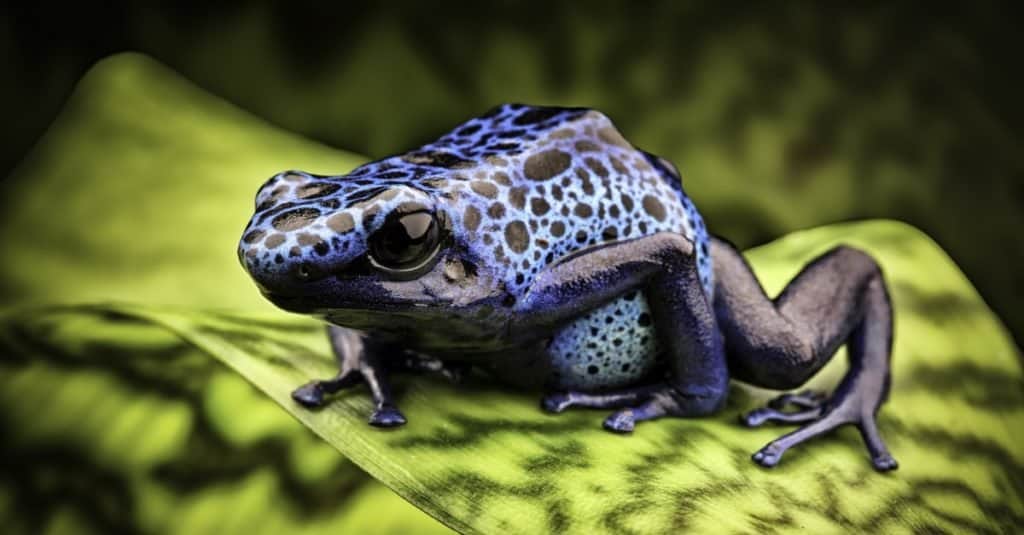
The skin of poison dart frogs contains poisonous toxins, with its coloring acting as a warning to other animals.
©Dirk Ercken/Shutterstock.com
You wouldn’t want to run into these frogs in the wild, so it is a good thing you can see them at the zoo! Their skin contains toxins that are poisonous and can be fatal. Their blue coloring serves as a warning to other predators of their poisonous threat.
They live in only a few areas of the rainforests in north Brazil and Suriname. They get their “dart frog” name from the hunters that would capture the frogs and dip the tips of their darts in the poison to create a lethal weapon.
Blue at the Movies
Blue animals are often movie stars. Let’s take a look at two animals that have recently been the leads in popular movies.
9. Spix’s Macaw: Blu from Rio
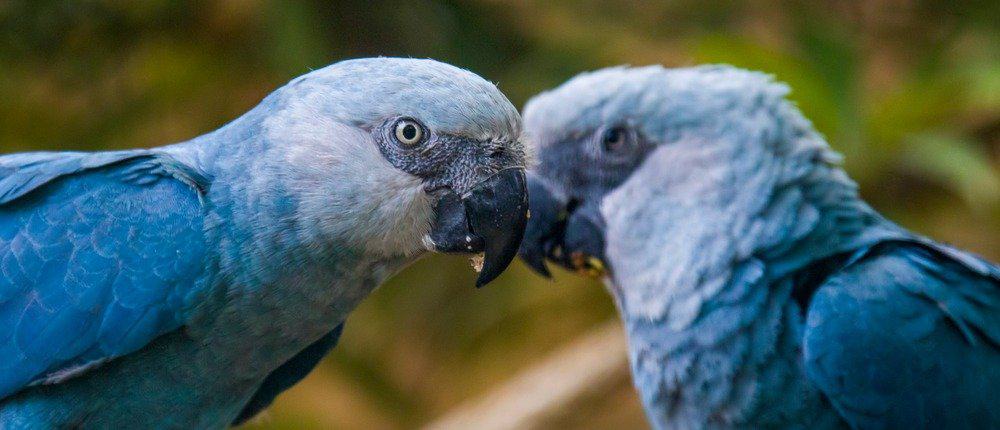
Spix’s macaws
are a beautiful blue!
©Danny Ye/Shutterstock.com
As his name states, Blu is a blue Spix’s macaw. This is one species of macaws that has vibrant blue feathers. In 2000, this bird was declared extinct in the wild and there are only a few (177) held in captivity. The movie Rio brought attention to the species as well as other parrots that may be in danger. When you think of a parrot, the blue and gold macaw may be the parrot you picture with blue wings, yellow belly and a green tuft on its head. They are more common and can be kept as companion pets.
8. Royal Blue Tang: Dory from Finding Nemo and Finding Dory

Royal blue tangs are a deep blue color.
©Charlotte Bleijenberg/Shutterstock.com
These fish are sometimes referred to as surgeonfish and are known for their deep blue bodies with yellow tail fin and yellow at the tip of their fins. They have a distinct black design on their side that people say looks like the number six. The average size of the blue tang is the size of an adult’s hand but can range from 4 to 14 inches in length. You’ve probably heard the phrase, “Play opossum,” if something plays dead, but you could also say, “Play Royal Blue Tang” (not as catchy), when threatened these fish will turn on their sides and act dead to deter predators.
Blue Aquarium Fish
Exotic fish are some of the most common blue animals on the planet. Let’s take a look at a couple blue fish that can be found in an aquarium near you!.
7. Blue Damselfish

Blue damselfish are popular aquarium fish.
©Pavaphon Supanantananont/Shutterstock.com
The aquariums at the dentist office are always so colorful. Often the blue fish chosen now are the Royal Blue Tang, like Dory, but the blue damselfish is actually the most popular blue aquarium fish. One reason they are popular is because they are like the little chihuahua at the dog park that is ready to take on the German shepherd. Owners find it entertaining to watch them try to take-on much bigger fish, especially since they are only typically 3-4 inches long!
6. Blue Sea Star (Star Fish)
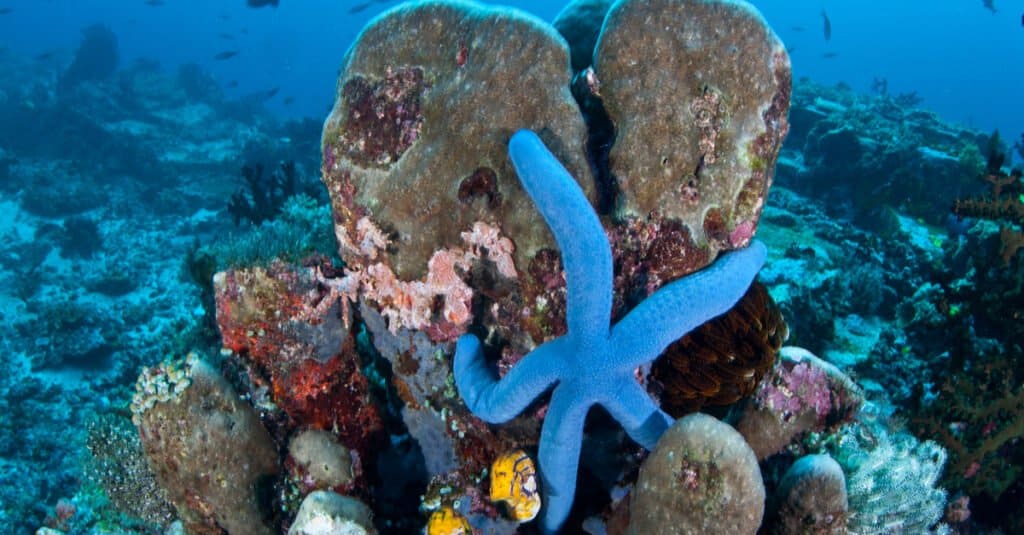
Blue sea stars live in shallow water often in reef habitats such as the Great Barrier Reef in Australia.
©Ethan Daniels/Shutterstock.com
Along with colorful fish, aquariums are often lined with colorful coral and sea stars. The blue sea star is vibrant blue and stands out. The arms of the sea star are 3-5 inches. The most common home for the sea star is shallow water frequently on reefs like the Great Barrier Reef. Some animals like the blue whale look blue in the water but are grey when they are out of the water. The blue sea star looks blue when it is removed from the water as well.
Blue in Your Backyard
Blue animals can even be found in your backyard! Here are a couple birds that are often found across North America and can add a little blue to your life.
5. Blue Jay
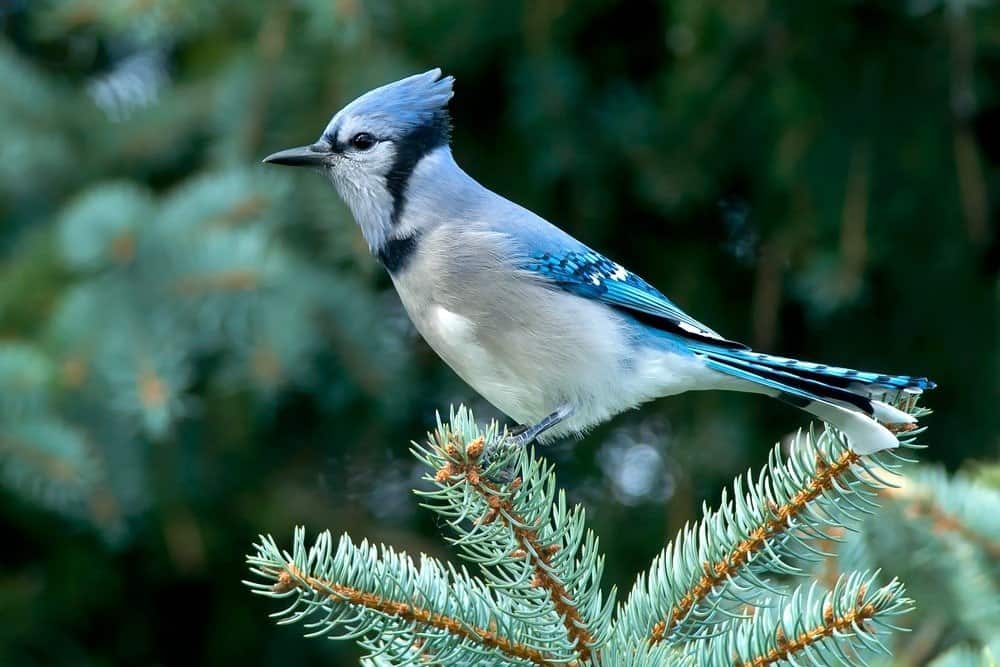
Blue jays
feed on nuts and insects.
©Paul Reeves Photography/Shutterstock.com
These common backyard birds have beautiful blue feathers in various shades of blue. According to allaboutbirds.com, “The pigment in Blue Jay feathers is melanin, which is brown. The blue color is caused by scattering light through modified cells on the surface of the feather barbs.”
Blue jays feed on nuts and insects and help the ecosystem by spreading acorns to grow more oak trees. If you are trying to lure them to your backyard try a feeder on a pole with suet, peanut butter and sunflower seeds.
4. Bluebird
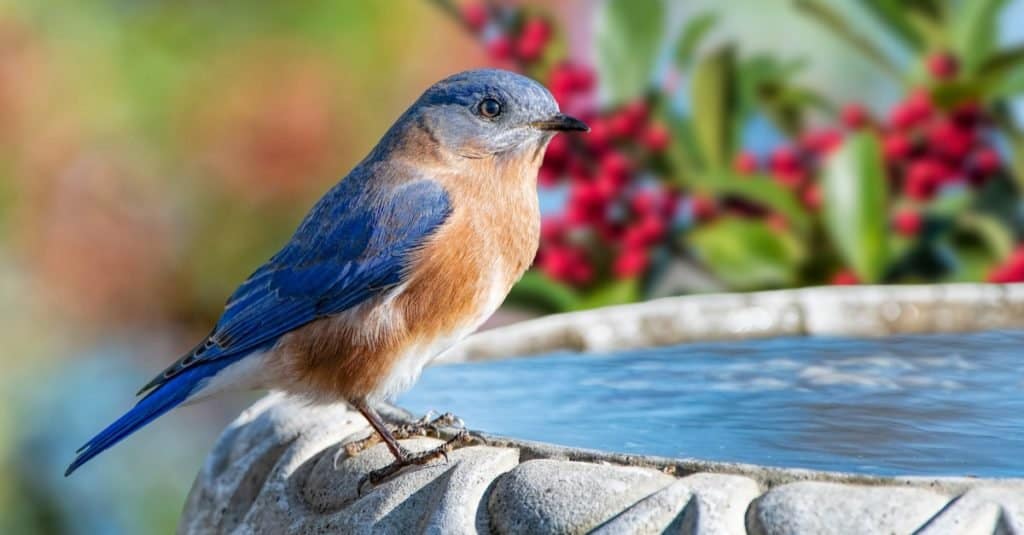
The scattering of light makes the
Eastern bluebird
appear to have blue feathers.
©Bonnie Taylor Barry/Shutterstock.com
The Eastern bluebird is another common bird that can be found in many backyards across North America. The male’s back feathers and wings are blue with their bellies a rust color. The females are grey on their backs with hints of blue in their wings and a tan belly.
Depending on the light they may not appear blue from a distance, but similar to the blue jay, the scattering of the light makes it appear that they have blue feathers. Another type of bluebird is the Mountain bluebird which is entirely blue (the males). They can be found in the Western states and frequent higher elevations.
Their diet consists mostly of insects and berries, but if they eat blueberries it won’t make them more blue!
Blue Pets
Unless you’re looking at the dog from Blue’s Clues, you probably won’t find a blue dog. However, both fish and lizards can be blue pets that can join a family for years. Let’s look at a couple of the favorite pets that are blue.
3. Betta Fish

A betta fish should be kept separate from another betta as they can fight if put together.
©Napat/Shutterstock.com
Want to get up close and personal with an incredible blue animal? Betta fish make great pets and you can observe the beautiful blue fins anytime. Betta’s have flowing fins that are quite impressive. They are sometimes called Siamese fighting fish based on their origin.
Bettas are from Thailand (used to be called Siam) and kids would gather these fish and put them together and watch them fight. Over the years different colors were introduced and bred to create a variety of colors. Bettas still fight if put together with one another, so it is recommended to only keep one Betta at a time or keep them separate.
2. Chameleon
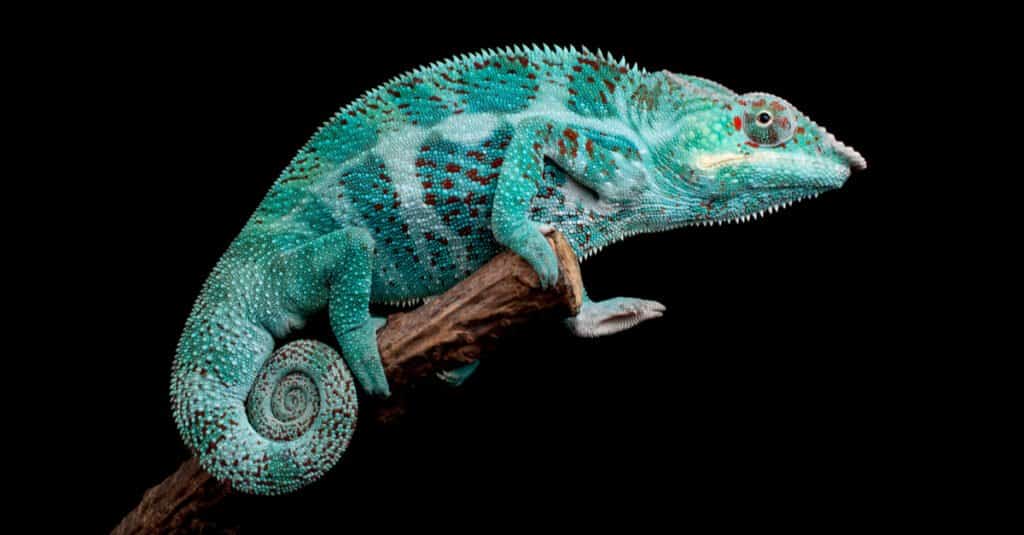
Chameleons can adjust their skin to be beautiful blue colors.
©Ferdy Timmerman/Shutterstock.com
Can’t decide what color pet you want? Try a chameleon that has the reputation of changing colors. They can’t match perfectly anything they land on but they can appear to change color.
Due to changes in hormones and nerve impulses the chameleon is able to alter the layer of skin that has melanin and create a look of a different color, including blue! One of the reasons chameleons change colors is to adjust their temperatures, drawing in more sun to warm them up or change color to cool off.
Blue and New to You
Finally, we have a blue animal that might be new to you! They’re a distinctive looking animal and one you won’t soon forget!
1. Blue Glaucus
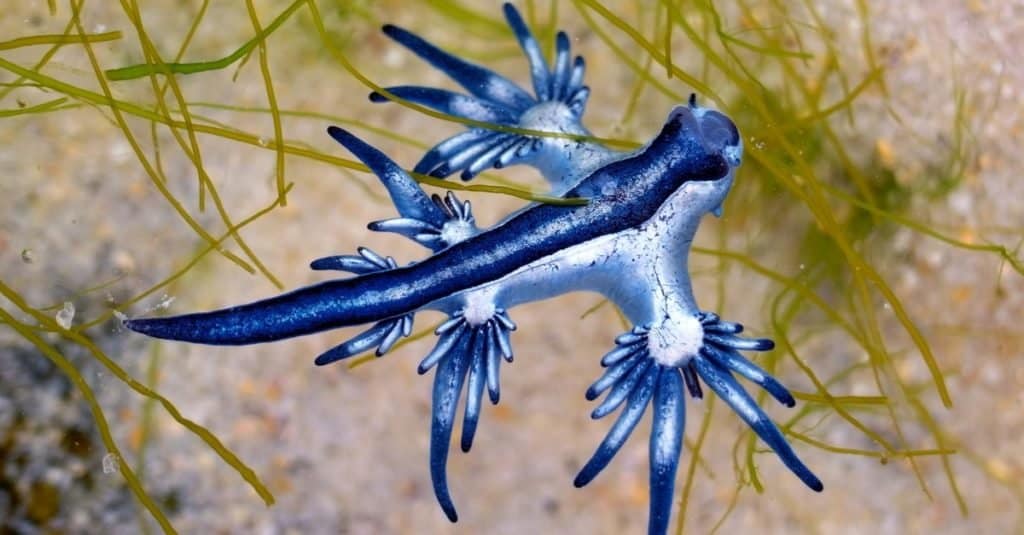
The Blue Dragon is blue to help it blend in with the reflective surface of the ocean.
©Sahara Frost/Shutterstock.com
Have you ever heard of a blue glaucus? These tiny sea slugs are only about an inch long and have flowing appendages all over it. They have a trick of doing the back float (by holding air in their stomach) with their bright blue belly up to help camouflage it from flying prey.
The blue glaucus blends in nicely with the ocean waters. They feed on Portuguese man o’ war and store the venom from them in their appendages as another form of predator protection. Because they are so small they are not likely to be the next fad animal like the axolotl!
Summary of 12 Incredible Blue Animals
Here’s a recap of the 12 incredible blue animals we examined today:
| Number | Animal |
|---|---|
| 1 | Blue Glaucus |
| 2 | Chameleon |
| 3 | Betta Fish |
| 4 | Bluebird |
| 5 | Blue Jay |
| 6 | Blue Sea Star (Star Fish) |
| 7 | Blue Damselfish |
| 8 | Royal Blue Tang |
| 9 | Spix’s Macaw |
| 10 | Blue Poison Dart Frog |
| 11 | Lizards |
| 12 | Peacock |
The photo featured at the top of this post is © Drop of Light/Shutterstock.com
Thank you for reading! Have some feedback for us? Contact the AZ Animals editorial team.






